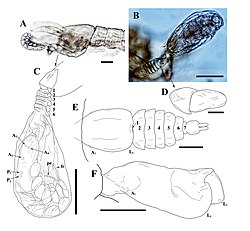Top Qs
Timeline
Chat
Perspective
Tantulocarida
Subclass of crustaceans From Wikipedia, the free encyclopedia
Remove ads
Tantulocarida is a highly specialised group of parasitic crustaceans that consists of about 33 species, treated as a class in superclass Multicrustacea. They are typically ectoparasites that infest copepods, isopods, tanaids, amphipods and ostracods.[2][3]
Remove ads
Description
This section needs expansion. You can help by adding to it. (November 2024) |
In the Tantulocarida, animals do not ever present eyes.[4]
The tantulus larvae has a head with a ventral oral disc but no appendages, a six-segmented thorax with six pairs of legs, and a limbless abdomen consisting of one to six segments in addition to a telson.[5] The larvae also possesses a cuticular stylet on the cephalon through which they can push a rootlet system for extraction of nutrients from a host. The rootlet system itself is a direct extension of the gut.[6]
Body length
Members of this subclass are minute – less than 0.3 millimetres (0.012 in) in length and have a dramatic reduction in body form compared to other crustaceans, with an unsegmented, sac-like thorax and a much reduced abdomen.[7] One tantulocarid species, Tantulacus dieteri, is the world's smallest arthropod, with a total body length of only 85 micrometres (0.0033 in).[8]
Remove ads
Life cycle
This section needs expansion. You can help by adding to it. (June 2018) |
The tantulocarid life cycle is unique among crustaceans. The tantulus larva transforms directly from a non-feeding (lecithotrophic) and free-swimming organism into a parasite without any instars. When entering the parasitic stage much of the body, such as the muscles, degenerates, even if the body itself becomes bigger. As a parasite it is permanently attached to its host, and after piercing its host's cuticle with an unpaired stylet, a rootlet system used to absorb nutrients enters through the hole and grow into the host's tissue. The adult form develops inside the larva, and can become either a sac-like parthenogenetic female, or a fully developed free-living, non-feeding and sexually-reproducing male or female.[9][10][11][12][13] The eggs inside the parthenogenetic female are eventually released as fully developed tantulus larvae. The finding of what appears to be a benthic non-feeding nauplius larva suggests that eggs produced by sexual females hatch as nauplii instead of tantulus larvae. Both the parthenogenetic and sexual females are semelparous.[14]
Remove ads
Classification
Five families are recognised:[15]
|
Basipodellidae Boxshall & Lincoln, 1983:[16]
Doryphallophoridae Huys, 1991:[17]
Microdajidae Boxshall & Lincoln, 1987:[18]
|
Cumoniscidae Nierstrasz & Brender à Brandis, 1923 (formerly family Deoterthridae:[19]
Onceroxenidae Huys, 1991:[20]
|
References
External links
Wikiwand - on
Seamless Wikipedia browsing. On steroids.
Remove ads

